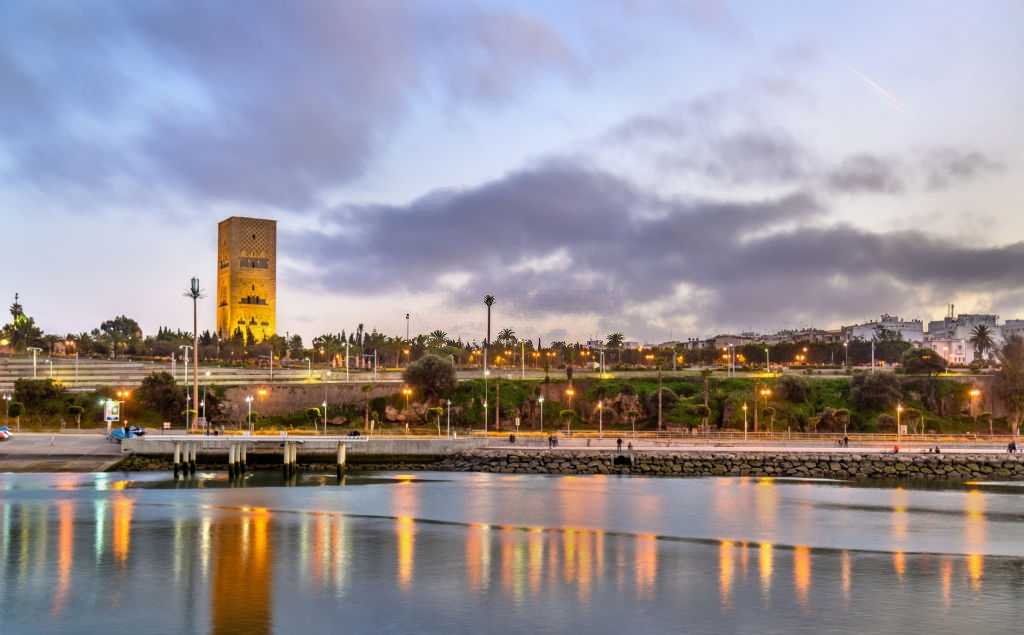Nestled at the crossroads of Africa, Europe, and the Middle East, Morocco is a land of remarkable cultural diversity and historical significance. From the windswept dunes of the Sahara Desert to the bustling streets of its vibrant cities, Morocco’s landscape is as diverse as its people and traditions. In this exploration, we embark on a journey to unravel the rich tapestry of Morocco’s cultural heritage, a mosaic woven from centuries of interaction between Berber, Arab, Andalusian, Jewish, and other influences. Join us as we delve into the rhythms of Moroccan life, discovering the ancient customs, vibrant arts, and enduring legacies that have shaped this enchanting land. From the mountain villages of the High Atlas to the coastal towns along the Mediterranean, Morocco beckons with tales of resilience, creativity, and the timeless beauty of human expression. So let us open our hearts and minds to the wonders of Morocco’s cultural heritage, embracing the diversity that makes this land a treasure trove of history, tradition, and endless discovery.
Experiencing the Flavors of Morocco: A Culinary Exploration
Moroccan cuisine is a delightful tapestry of flavors, spices, and culinary traditions that reflect the country’s diverse cultural influences. From the savory depths of tagines to the sweet indulgence of pastries, Moroccan food is a sensory journey that tantalizes the taste buds and leaves a lasting impression on all who partake. Let’s delve deeper into the world of Moroccan cuisine and discover what makes it so famous.

Tagines:
Tagine is perhaps the most iconic dish of Moroccan cuisine, named after the earthenware pot in which it is cooked. These slow-cooked stews are a hearty amalgamation of tender meat (often lamb or chicken), vegetables, fruits, and a symphony of spices such as cumin, paprika, cinnamon, and saffron.
The slow cooking process allows the flavors to meld together, resulting in a dish that is both aromatic and deeply satisfying.
Tagines come in various forms, from the classic lamb tagine with prunes and almonds to the vegetarian-friendly options featuring chickpeas, squash, and preserved lemons.
Couscous:
Couscous holds a special place in Moroccan cuisine as a staple food that is served on festive occasions and everyday meals alike. This tiny granular semolina pasta is steamed and fluffed to perfection, serving as a versatile base for a myriad of toppings and accompaniments.
Traditional Moroccan couscous is often paired with a rich stew made from lamb, chicken, or vegetables, along with a medley of seasonal vegetables such as carrots, zucchini, and potatoes.
The art of making couscous is deeply ingrained in Moroccan culture, with families often gathering together to hand-roll and steam the couscous grains, passing down time-honored techniques from generation to generation.

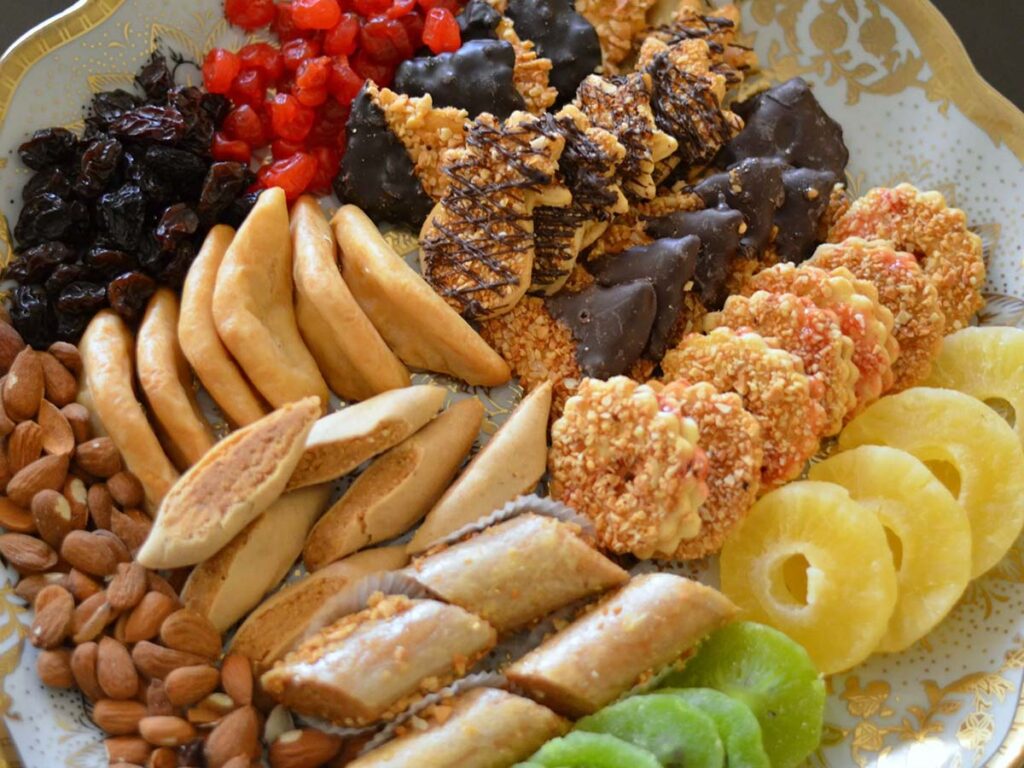
Moroccan Pastries:
Moroccan pastries are a symphony of sweetness, often featuring delicate layers of phyllo dough, nuts, and honey infused with floral essences such as orange blossom and rose water.
Baklava, perhaps the most famous of Moroccan pastries, is a decadent treat made from layers of crisp phyllo pastry filled with chopped nuts and sweetened with honey or syrup.
Other popular Moroccan pastries include chebakia, a sesame-coated cookie with hints of anise and orange blossom, and ma’amoul, a date-filled shortbread cookie dusted with powdered sugar.
Mint Tea:
No discussion of Moroccan cuisine would be complete without mentioning mint tea, affectionately known as “Moroccan whiskey.” This ubiquitous drink is a symbol of hospitality and is enjoyed throughout the day in homes, cafes, and marketplaces.
Moroccan mint tea is made by steeping green tea leaves with fresh mint sprigs and generous amounts of sugar, resulting in a refreshing and aromatic brew.
The tea is traditionally poured from a height to create a frothy foam, a technique that adds to the theatricality of the tea ceremony and enhances the overall drinking experience.
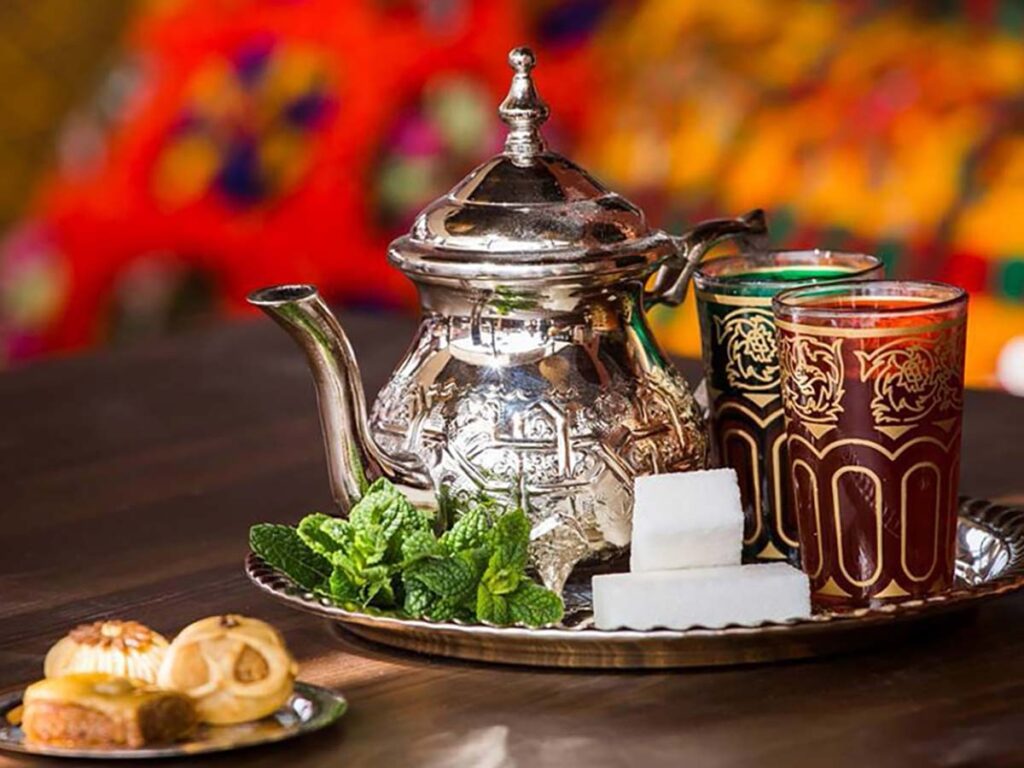
Moroccan cuisine is a true reflection of the country’s rich history, diverse cultural influences, and deep-rooted traditions. From the fragrant spices of tagines to the delicate sweetness of pastries, each dish tells a story and invites you to embark on a culinary journey unlike any other. So savor the flavors, embrace the aromas, and immerse yourself in the culinary wonders of Morocco.
Architectural Splendors of Morocco: A Journey Through Time and Culture
Morocco’s architectural landscape is a mesmerizing blend of ancient traditions, intricate craftsmanship, and cultural influences spanning centuries. From the majestic mosques of Casablanca to the labyrinthine streets of medieval medinas, Morocco’s architectural marvels offer a glimpse into the country’s rich history and vibrant heritage. Let’s embark on a journey through some of the most iconic architectural wonders of Morocco.
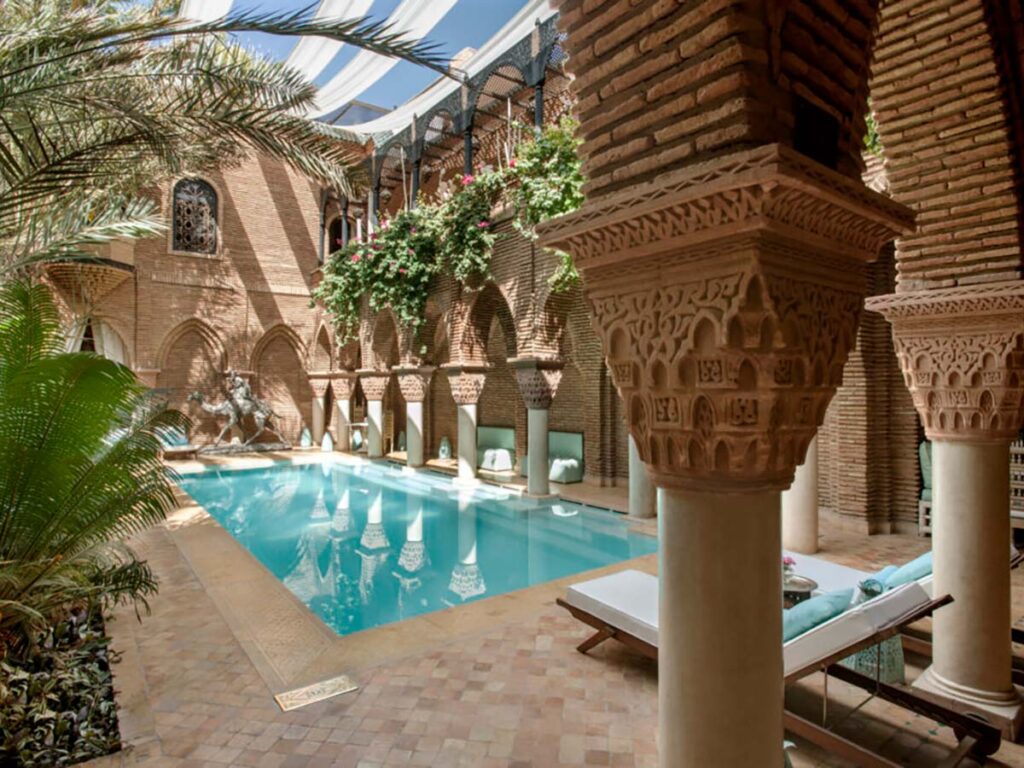
Moroccan Riads:
Riads are traditional Moroccan houses built around a central courtyard, often adorned with lush gardens, ornate fountains, and intricately tiled mosaics.
These hidden gems provide a tranquil oasis amidst the hustle and bustle of Moroccan cities, offering a glimpse into the intimate family life and architectural heritage of Morocco.
Riads have been lovingly restored and transformed into boutique hotels and guesthouses, allowing visitors to experience the beauty and serenity of traditional Moroccan architecture firsthand.
Moorish Architecture:
Moorish architecture, characterized by its intricate geometric patterns, horseshoe arches, and ornate tilework, has left an indelible mark on Moroccan design.
The iconic Hassan II Mosque in Casablanca is a prime example of Moorish architecture, with its soaring minaret, intricate marble carvings, and expansive prayer hall that can accommodate up to 25,000 worshippers.
Other notable examples of Moorish architecture in Morocco include the Mausoleum of Mohammed V in Rabat and the Al-Attarine Madrasa in Fez, each showcasing the beauty and sophistication of this timeless architectural style.
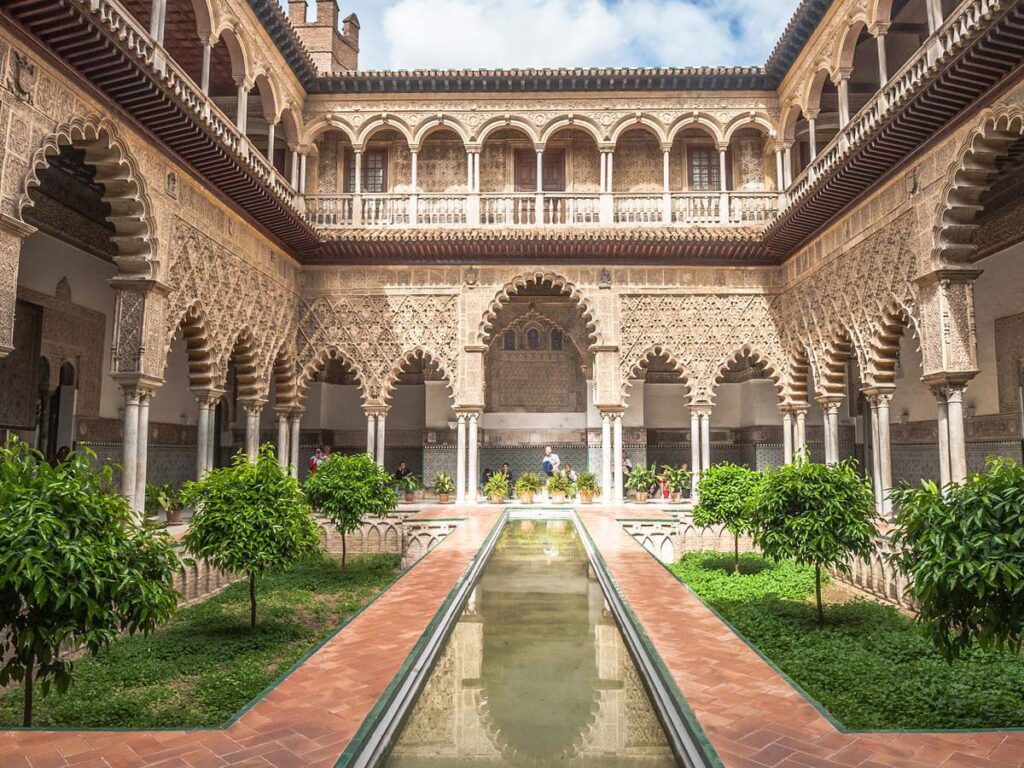

Berber Kasbahs:
Kasbahs are fortified citadels that dot the Moroccan landscape, serving as defensive strongholds, palaces, and trading hubs for centuries.
These ancient structures, constructed from rammed earth and clay, are characterized by their towering walls, labyrinthine alleys, and panoramic views of the surrounding countryside.
The Kasbah of Ait Ben Haddou, a UNESCO World Heritage site, is one of the most famous kasbahs in Morocco, known for its picturesque setting amidst the desert landscape and its appearance in numerous films and television shows.
Andalusian Gardens:
Andalusian gardens, inspired by the lush gardens of Moorish Spain, are a hallmark of Moroccan architecture, with their tranquil water features, fragrant citrus trees, and colorful flowerbeds.
The Majorelle Garden in Marrakech, created by French painter Jacques Majorelle in the 1920s, is a prime example of Andalusian garden design, featuring a vibrant blue villa, exotic plant species, and a tranquil oasis in the heart of the city.
Other notable Andalusian gardens in Morocco include the Menara Gardens in Marrakech and the Jardin exotique in Casablanca, each offering a serene escape from the urban hustle and bustle.
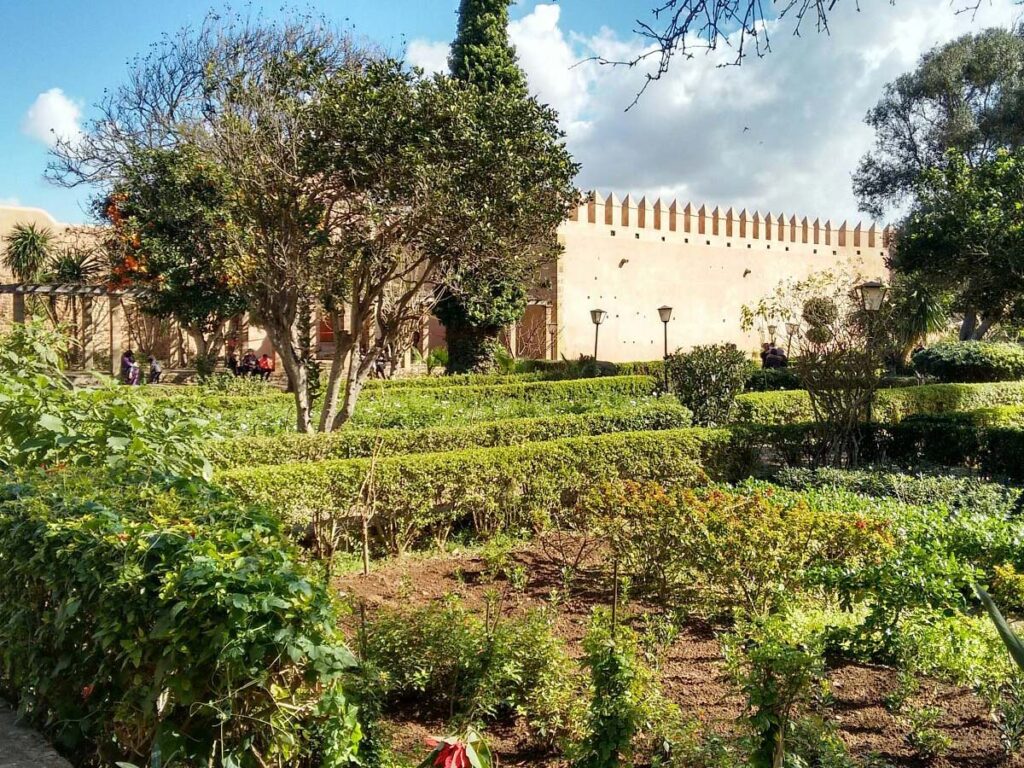
From the ornate riads of Marrakech to the ancient kasbahs of the desert, Morocco’s architectural marvels are a testament to the country’s rich cultural heritage and timeless beauty. Whether you’re marveling at the intricate tilework of a mosque or strolling through a verdant Andalusian garden, each architectural wonder invites you to step back in time and immerse yourself in the magic of Morocco’s storied past.
Exploring the Vibrant Souks and Markets of Morocco
Morocco’s souks and markets are vibrant hubs of activity where the rich tapestry of the country’s culture and commerce unfolds before your eyes. From the maze-like alleys of the ancient medinas to the bustling squares filled with merchants and artisans, Morocco’s markets offer a sensory feast that is as exhilarating as it is enchanting. Let’s delve into the unique world of Moroccan souks and markets and discover what makes them such a vital part of the country’s identity.
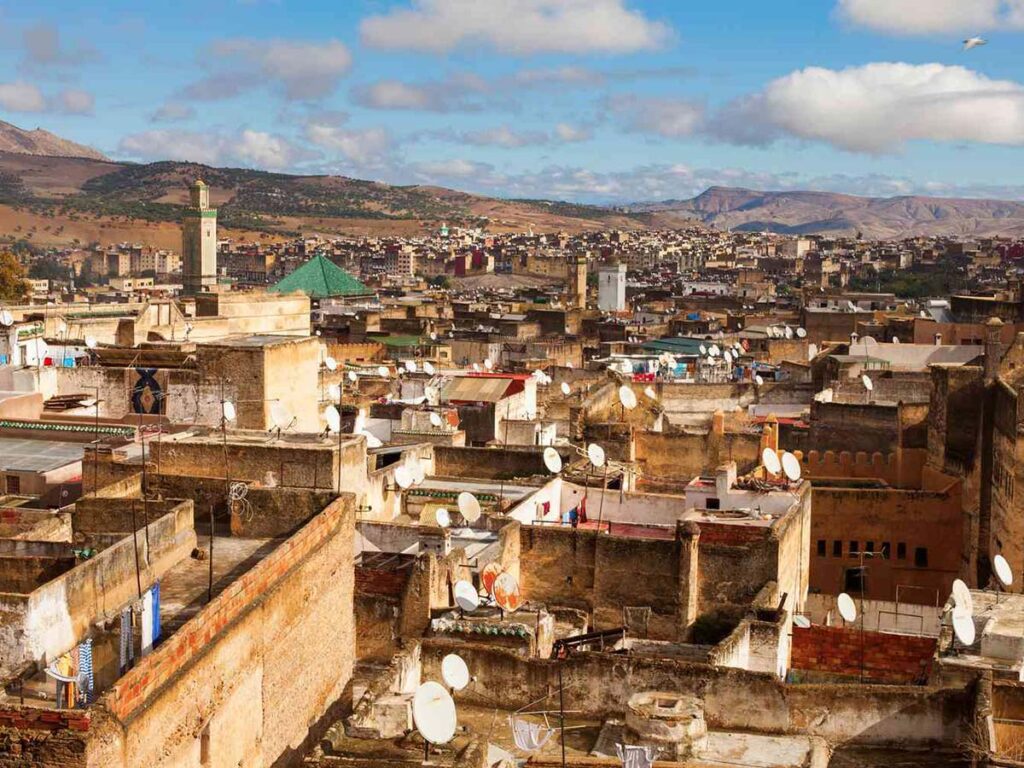
Medinas:
Medinas are the historic old towns of Moroccan cities, characterized by their labyrinthine alleyways, towering city walls, and bustling marketplaces.
These ancient quarters are home to some of Morocco’s most vibrant souks, where traditional crafts, spices, textiles, and souvenirs are bought and sold amidst a cacophony of sights, sounds, and smells.
Each medina has its own distinct character and specialties, whether it’s the leather goods of the tanneries in Fez, the carpets and textiles of Marrakech, or the silverware and pottery of Chefchaouen.
Djemaa el Fna:
Djemaa el Fna, located in the heart of Marrakech’s medina, is perhaps the most famous square in Morocco and a UNESCO World Heritage site.
By day, the square is a lively marketplace where vendors sell fresh orange juice, dried fruits, and nuts, while snake charmers, acrobats, and storytellers entertain the crowds.
By night, Djemaa el Fna transforms into a bustling open-air food market, with rows of food stalls serving up Moroccan specialties such as tagines, grilled meats, and couscous under the glow of lanterns and twinkling stars.
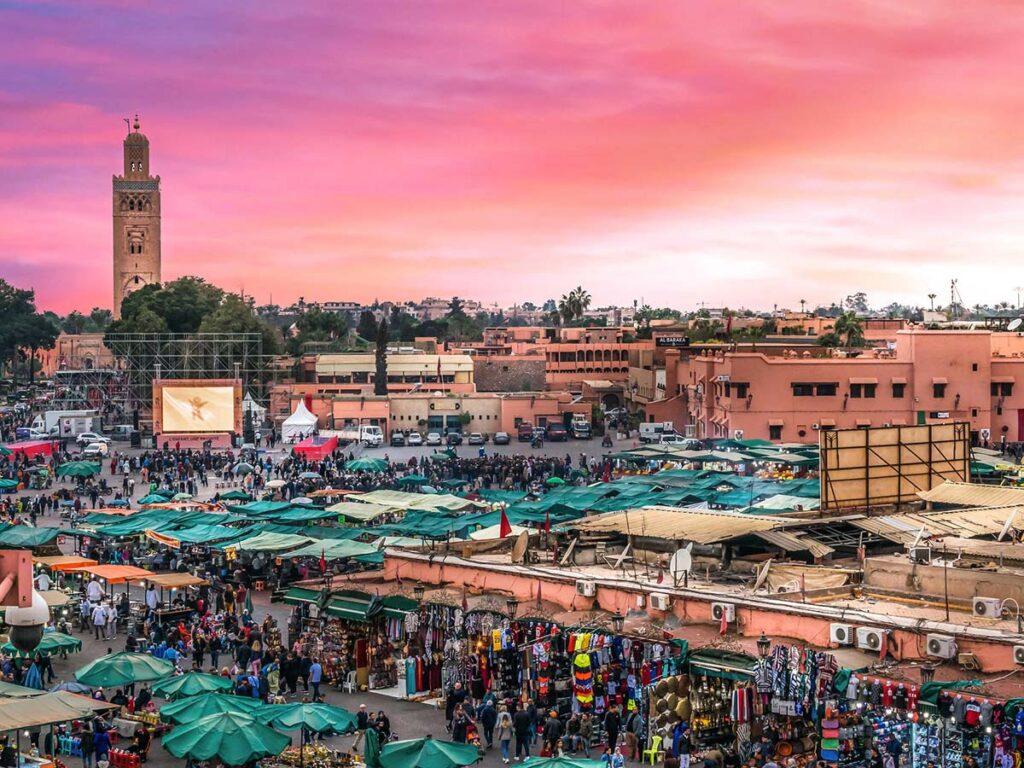
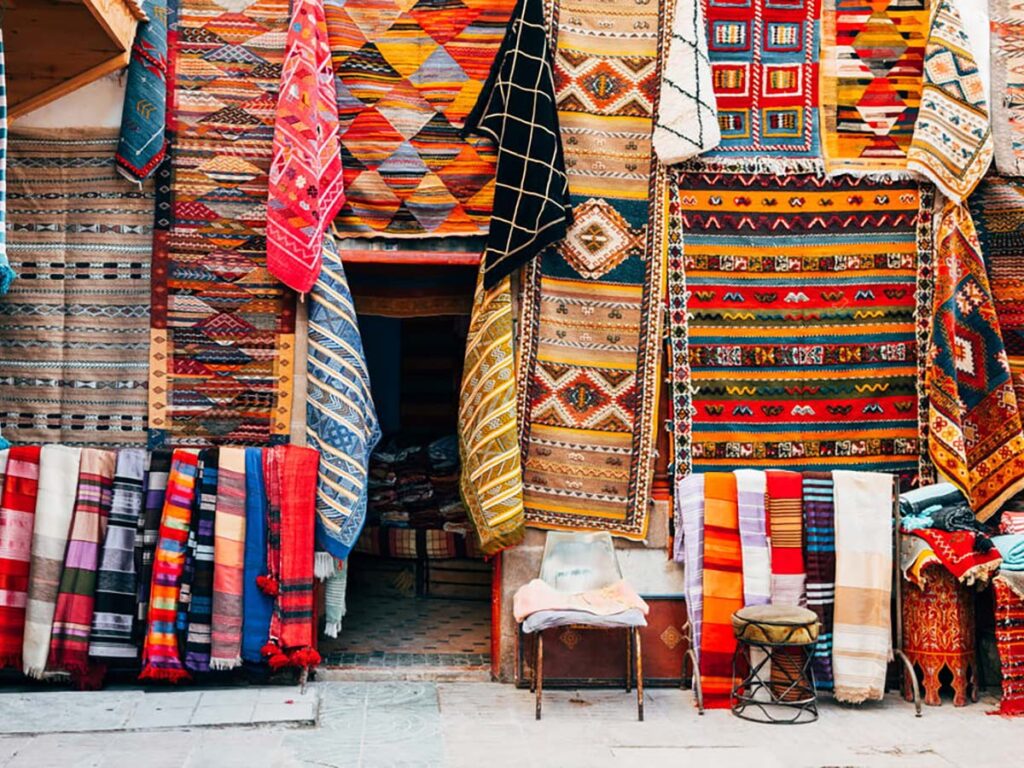
Traditional Crafts:
Moroccan souks are renowned for their exquisite craftsmanship and artisanal traditions, with generations of artisans honing their skills and passing down their techniques from one generation to the next.
Visitors to Moroccan markets can browse an array of traditional crafts, including handwoven carpets, intricate metalwork, vibrant ceramics, and delicate textiles.
Many artisans work directly in the souks, allowing visitors to witness the creative process firsthand and purchase unique, handmade souvenirs directly from the craftsmen themselves.
Bargaining and Etiquette:
Bargaining is an integral part of the shopping experience in Moroccan markets, with prices often starting higher than what a vendor expects to receive.
Visitors should approach bargaining with a sense of humor and respect, engaging in friendly banter with vendors while negotiating a fair price for goods.
It’s also important to observe cultural etiquette while shopping in Moroccan markets, such as dressing modestly, asking permission before taking photographs, and refraining from haggling over small-ticket items or with vendors who appear to be struggling financially.
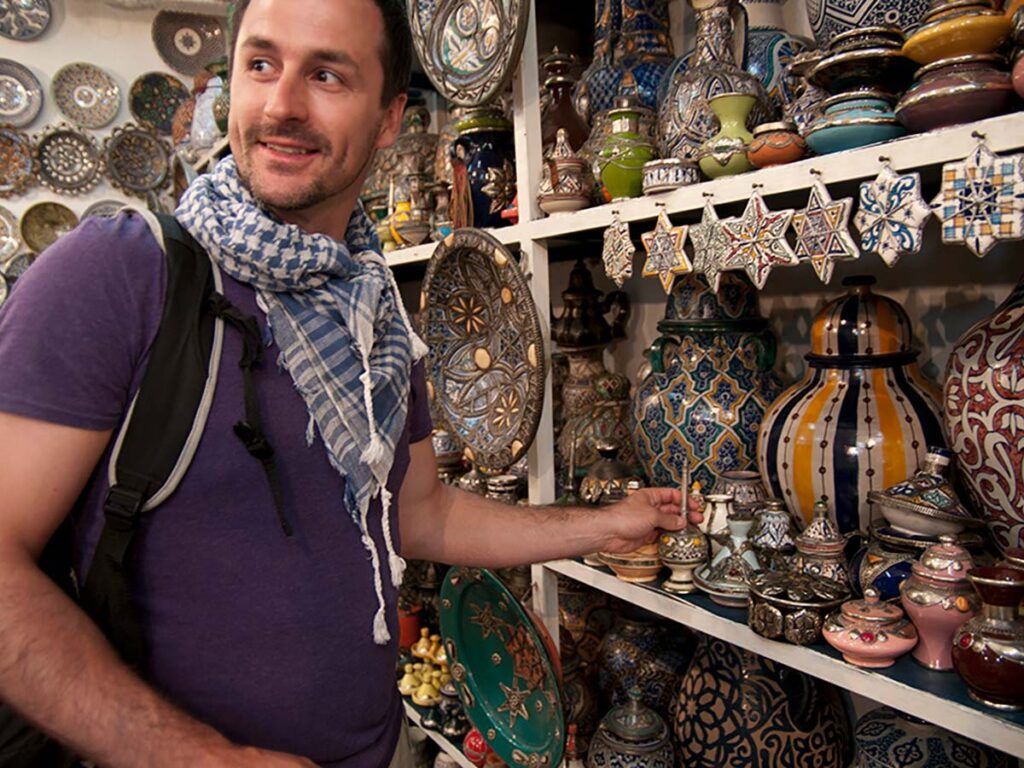
Morocco’s souks and markets are not just places to shop, but vibrant centers of culture, tradition, and community where the essence of Moroccan life unfolds before your eyes. Whether you’re navigating the labyrinthine alleys of a medina, sampling street food at Djemaa el Fna, or haggling with artisans over handmade treasures, a visit to Morocco’s markets is an experience that will awaken your senses and leave an indelible imprint on your soul.
Embarking on Sahara Desert Adventures: Exploring Morocco’s Golden Sands
The Sahara Desert, with its endless expanse of golden sands and towering dunes, is one of Morocco’s most iconic and captivating destinations. A journey into the heart of the Sahara promises adventure, wonder, and unforgettable experiences beneath the starlit desert sky. Let’s delve into the myriad adventures that await in Morocco’s Sahara Desert.
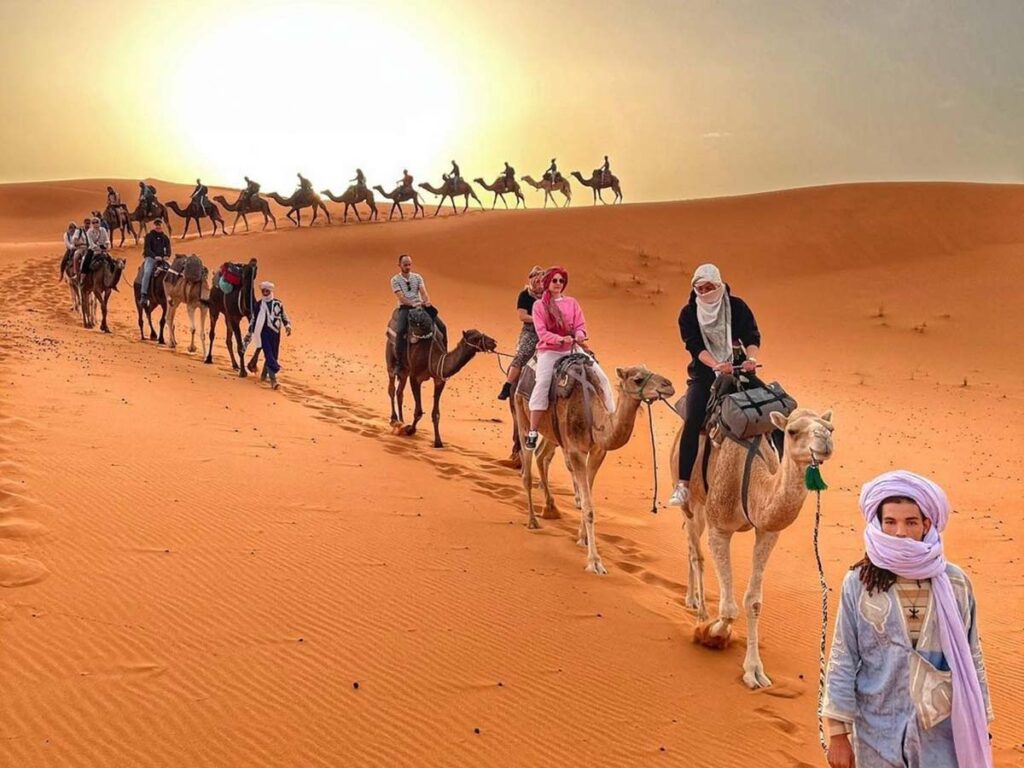
Camel Trekking:
Camel trekking is perhaps the quintessential Sahara Desert experience, offering travelers the opportunity to traverse the vast desert landscape atop these majestic “ships of the desert.”
Experienced guides lead camel caravans through the dunes, allowing travelers to immerse themselves in the rhythm of the desert and witness breathtaking sunrises and sunsets over the horizon.
Overnight camel treks offer the chance to camp beneath the stars in traditional Bedouin-style tents, where the silence of the desert and the brilliance of the night sky create an atmosphere of unparalleled serenity.
Desert Camping
Spending a night under the desert sky is a highlight of any Sahara Desert adventure. Several campsites nestled among the dunes offer travelers the opportunity to experience the magic of the desert firsthand.
Bedouin-style tents provide comfortable accommodations amidst the sands, while communal areas allow travelers to gather around crackling campfires and indulge in traditional Moroccan cuisine.
After sunset, the desert comes alive with the twinkle of countless stars, offering a celestial spectacle that is truly awe-inspiring and humbling.
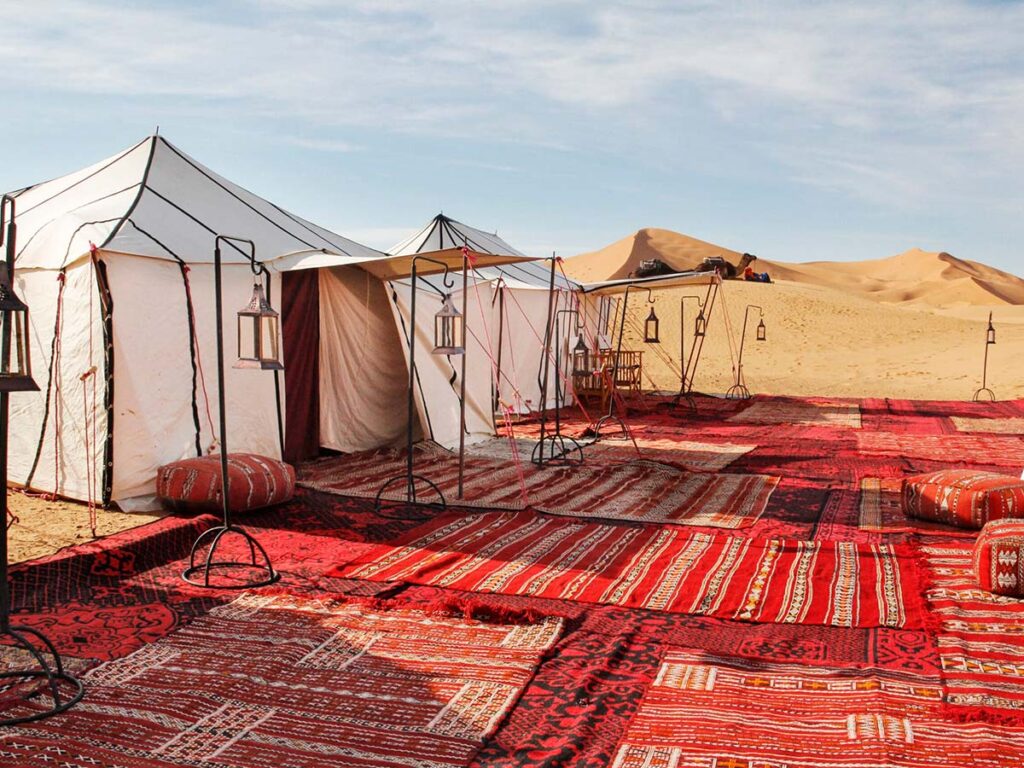
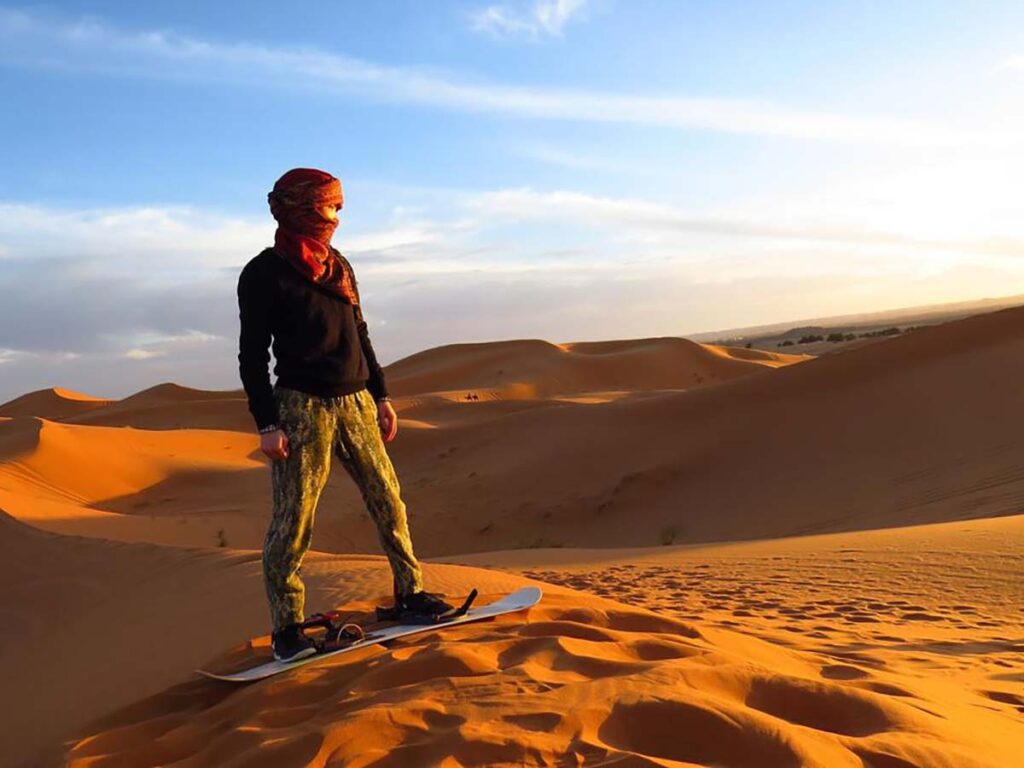
Sandboarding:
For thrill-seekers and adrenaline junkies, sandboarding down the towering dunes of the Sahara is an exhilarating experience not to be missed.
Equipped with a sandboard, adventurers can carve their way down the sandy slopes, feeling the rush of wind against their faces as they descend into the valley below.
Sandboarding is suitable for all skill levels, with instructors available to provide guidance and ensure a safe and enjoyable experience for participants of all ages.
Desert Exploration
Beyond the dunes, the Sahara Desert is home to a wealth of natural wonders waiting to be discovered. Guided desert treks offer travelers the chance to explore hidden oases, ancient caravan routes, and remote desert villages.
Experienced guides lead travelers off the beaten path, sharing their knowledge of the desert’s flora, fauna, and geological formations along the way.
From fossil-rich valleys to dramatic rock formations, each excursion into the desert unveils a new facet of this vast and enchanting landscape.
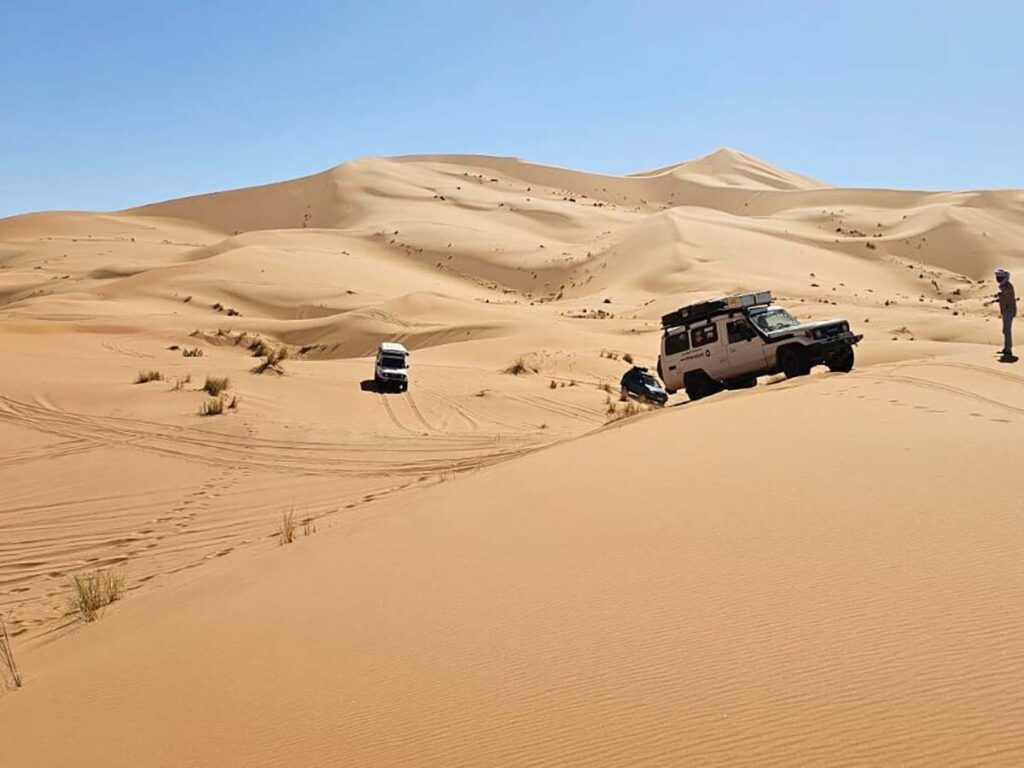
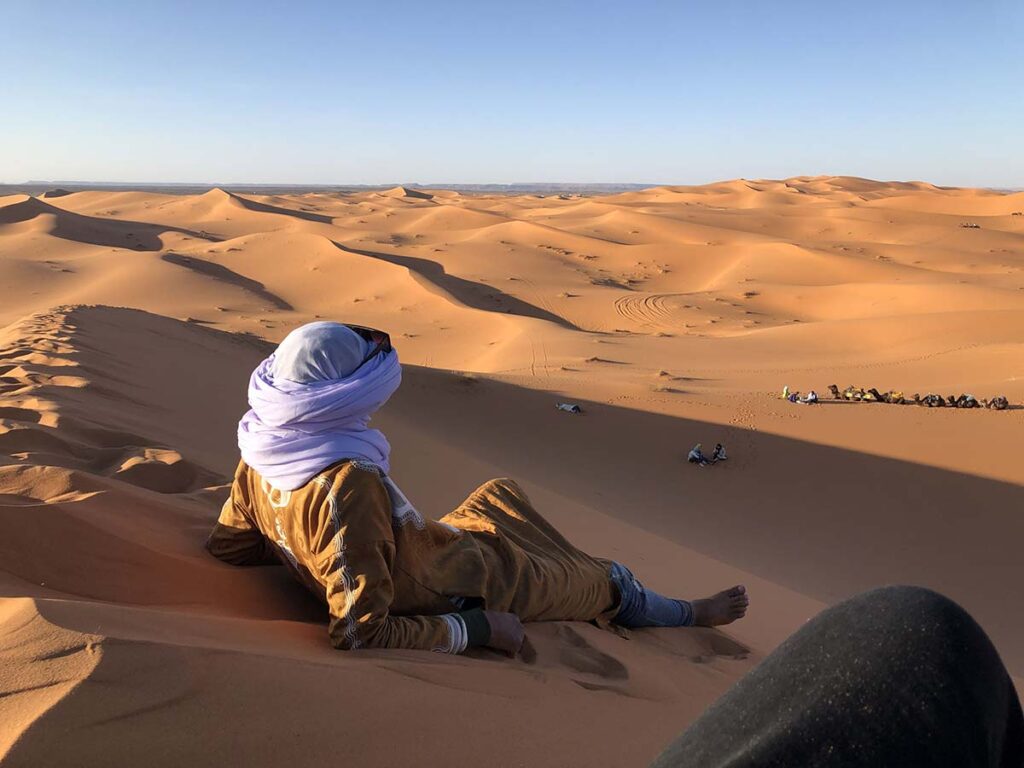
Cultural Encounters:
A journey into the Sahara Desert is also an opportunity to connect with the indigenous Berber and Tuareg communities who call this harsh yet beautiful environment home.
Travelers can visit nomadic settlements, where they are welcomed with warm hospitality and invited to learn about traditional desert life, including camel husbandry, rug weaving, and tea ceremonies.
These cultural encounters offer a deeper understanding of the rich history and enduring resilience of the desert-dwelling peoples of Morocco.
Embarking on a Sahara Desert adventure is a journey into the unknown, a chance to explore a landscape of unparalleled beauty and discover the enduring spirit of the desert. Whether you’re trekking across the dunes on camelback, sandboarding down towering slopes, or camping beneath a blanket of stars, the Sahara Desert promises an adventure that will leave you with memories to last a lifetime.
Unveiling Morocco’s Rich Cultural Heritage: A Tapestry of Traditions
Morocco’s cultural heritage is a vibrant tapestry woven from centuries of history, diverse influences, and enduring traditions. From the colorful rituals of daily life to the captivating rhythms of music and dance, Morocco’s cultural landscape is as rich and diverse as the land itself. Let’s delve into the intricacies of Morocco’s cultural heritage and explore the elements that make it so unique and captivating.
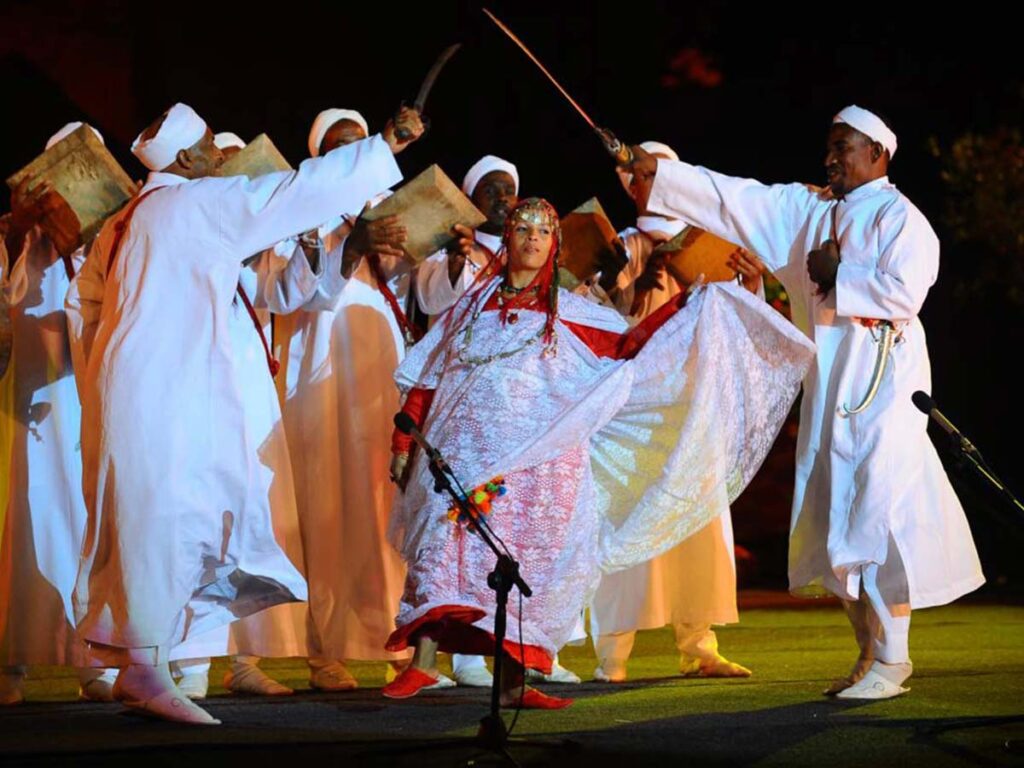
Berber Traditions:
The indigenous Berber people are an integral part of Morocco’s cultural fabric, with a rich heritage that dates back thousands of years.
Berber traditions encompass a wide range of practices, including music, dance, cuisine, and craftsmanship, each reflecting the unique identity and worldview of the Berber communities.
Visitors to Morocco can immerse themselves in Berber culture by attending festivals, visiting rural villages, and participating in cultural workshops that showcase traditional Berber arts and crafts.
Islamic Architecture:
Morocco’s architectural heritage is deeply influenced by Islamic design principles, with mosques, madrasas, and palaces adorned with intricate geometric patterns, ornate tilework, and towering minarets.
The architecture of Morocco’s imperial cities, such as Marrakech, Fez, and Meknes, reflects the grandeur and sophistication of Islamic art and architecture, with landmarks such as the Koutoubia Mosque and the Al-Qarawiyyin Mosque standing as testaments to the country’s rich architectural heritage.
Visitors can explore these architectural marvels on guided tours or wander through the narrow streets of Morocco’s medinas, where hidden gems await around every corner.
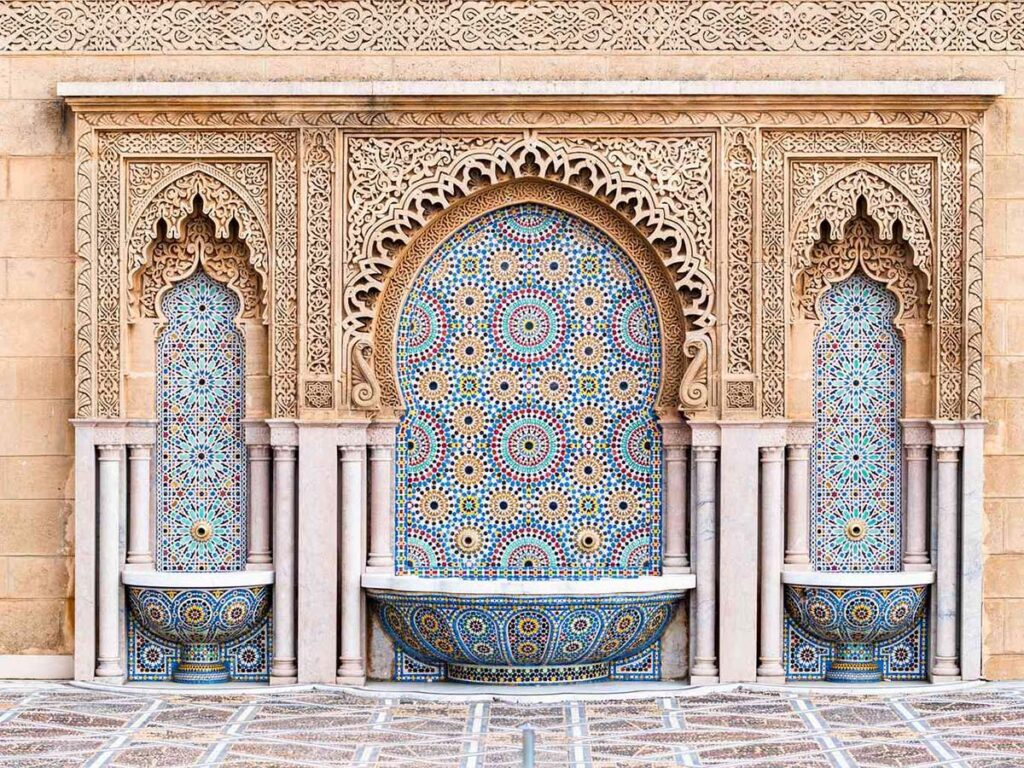
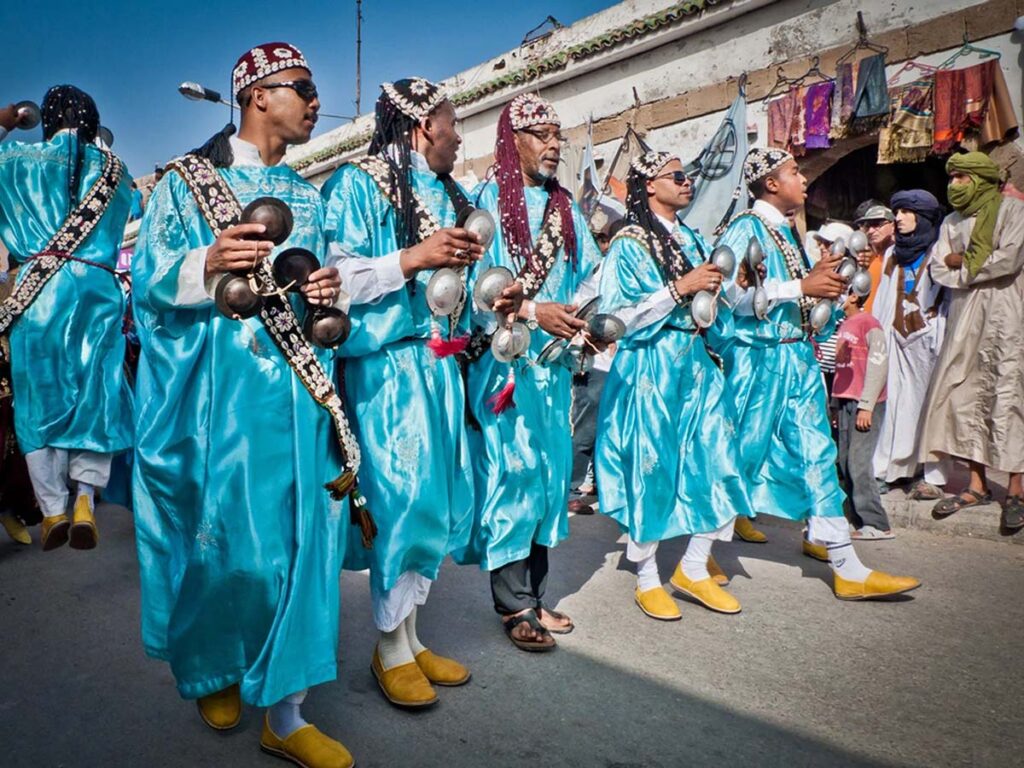
Gnawa Music and Dance:
Gnawa music is a form of traditional Moroccan music with roots in Sub-Saharan Africa and Islamic mysticism, characterized by hypnotic rhythms, haunting melodies, and spirited dance.
Gnawa music is often performed during religious ceremonies and cultural festivals, with musicians playing traditional instruments such as the guembri (a three-stringed bass lute) and the qraqeb (metal castanets).
Travelers can experience the magic of Gnawa music and dance at performances held in venues across Morocco, from intimate riads to bustling squares, where the infectious rhythms and soulful melodies inspire audiences to join in the celebration.
Festivals and Celebrations:
Morocco is home to a vibrant calendar of festivals and celebrations that showcase the country’s cultural diversity and artistic heritage.
From religious festivals such as Eid al-Fitr and Eid al-Adha to cultural events like the Festival of Roses in El Kelaa M’gouna and the Gnaoua World Music Festival in Essaouira, there are countless opportunities to experience the joy and camaraderie of Moroccan celebrations.
Festivals often feature music, dance, storytelling, and traditional crafts, providing a window into the heart and soul of Moroccan culture.
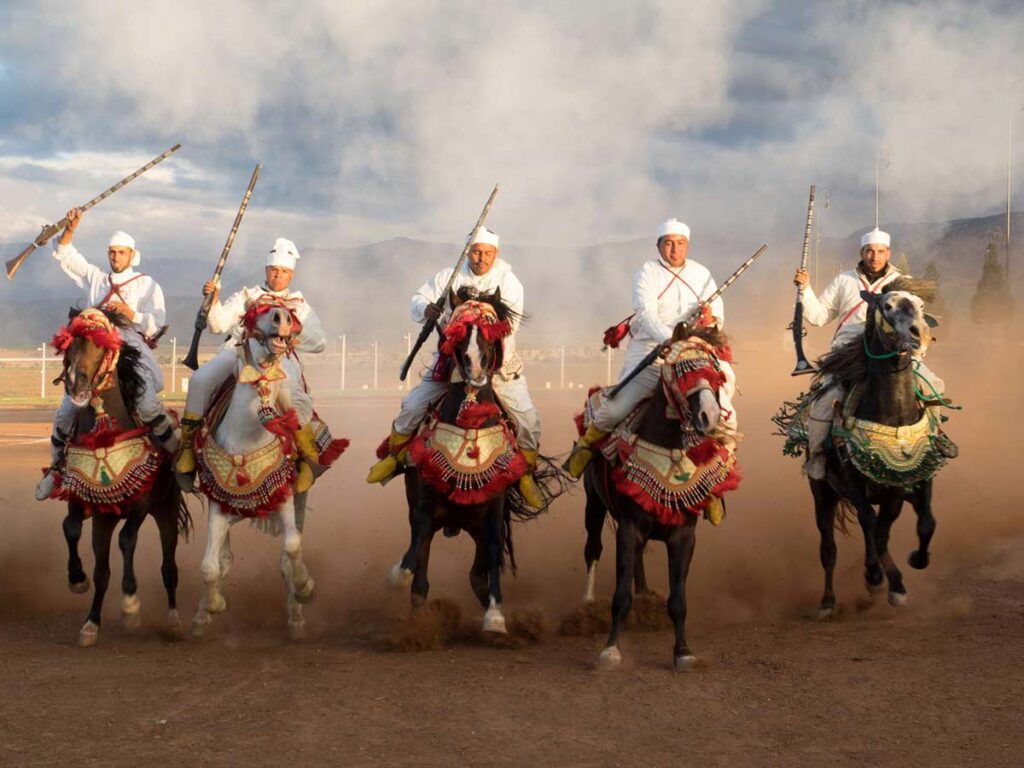
Morocco’s cultural heritage is a treasure trove of traditions, rituals, and artistic expressions that have been passed down through generations. Whether you’re exploring the labyrinthine streets of a medieval medina, savoring the flavors of a traditional Moroccan meal, or dancing to the rhythms of Gnawa music beneath the desert stars, each experience offers a glimpse into the rich tapestry of Moroccan culture and the enduring spirit of its people.
As we reach the end of our journey through Morocco’s enchanting wonders, we’re reminded of the timeless allure and boundless beauty of this captivating land. From the intricate architecture of its historic palaces to the tantalizing flavors of its cuisine, Morocco is a destination that captures the imagination and leaves a lasting impression on all who visit.
Through bustling souks and tranquil oases, across sweeping desert landscapes and into vibrant medinas, we’ve experienced the rich tapestry of Moroccan culture and heritage. We’ve marveled at the craftsmanship of artisans, danced to the rhythms of traditional music, and savored the warmth of Berber hospitality.
But beyond its tangible treasures, Morocco is a place of connection and discovery—a melting pot of cultures, traditions, and stories waiting to be shared. It’s a land where past and present intertwine, where ancient customs coexist with modern innovations, and where every corner holds the promise of adventure and wonder.
So as we bid farewell to Morocco, let us carry with us the memories of its vibrant markets, the echoes of its desert sands, and the spirit of its people. And let us remember that the magic of Morocco will always beckon, inviting us to return and continue our exploration of this extraordinary land. Until we meet again, may the spirit of Morocco’s beauty and hospitality stay with us, inspiring our journeys and enriching our lives.

